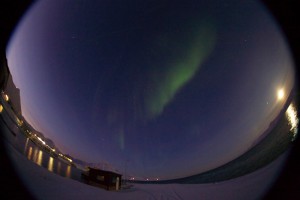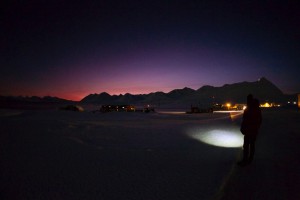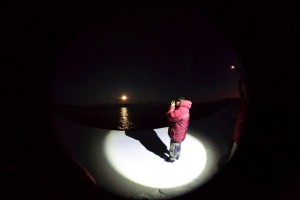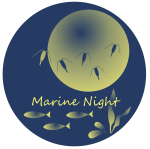Yesterday we left Longyearbyen with all our equipment, colleges and students. Months of planning and preparing have ended, and we are now in place in Ny-Ålesund where we will carry out the largest polar night expedition ever conducted (at least to our knowledge). It took us two and a half airfreights to get here, but even then we had to leave a lot behind. Fortunately there was room for all our students – the rest will come with group II on RV Helmer Hanssen on Thursday.

Fish eye picture of the sky – in the south behind Ny-Ålesund the red sunlit sky, in the northeast a bright moon and straight above the flickering northern lights. Who said the polar night was just a dull darkness? (Picture: Geir Johnsen)
We were met by a surprisingly mild weather – nearly clear skies and around 0°C. And no water. Or at least a critical shortage of drinking water in the settlement. However, and more importantly, we woke up this morning to a truly sparkling polar night – no clouds, a bright and almost full moon, northern lights and a green laser beam from one of the research stations pointing straight up into the sky. The colours that filled the sky today was simply extraordinary and beautiful. Seeing this today, amidst all thinkable and unthinkable problems with instruments and gadgets reminds us why we are here – to lure away from mother nature some of the most well kept secrets on the planet, the secrets of the polar night. Using the best underwater technology available and a group of 21 motivated and inspiring young students. Over the next two weeks, this will be our main ambition. And we will focus our attention towards yet another source of light – the bluegreen light that so many marine organisms produce at this time; bioluminescence (morild in Norwegian). This kind of light is otherwise very well known from especially the deep oceans, but here at the high latitudes of Svalbard (79°N) it becomes a characteristic phenomenon also of shallow waters during the polar night. Why do organisms produce such light? What significance does it hold in the everlasting game between organisms looking for food and organisms trying to avoid becoming exactly that? And how do we measure it in real life in the ocean during the polar night? This will be our tasks over the next two weeks, and on the way we will deploy and use a wide array of underwater platform and sensors – most of which are brought up into the polar night in close cooperation with the AMOS Centre for Excellence on underwater robotics at NTNU.
The expedition is lead by UiT, and the biggest component of the 65 man (and women!) strong team is a UNIS course on underwater robotics and polar night biology. At the moment, we are 32 researchers and students established in Ny-Ålesund, but our college Stig Falk-Petersen is coming up with Helmer Hanssen and 28 others on Thursday. The last participants are coming with a plane on Friday. And together we will be searching for dark secrets all over Kongsfjorden over the next two weeks!




